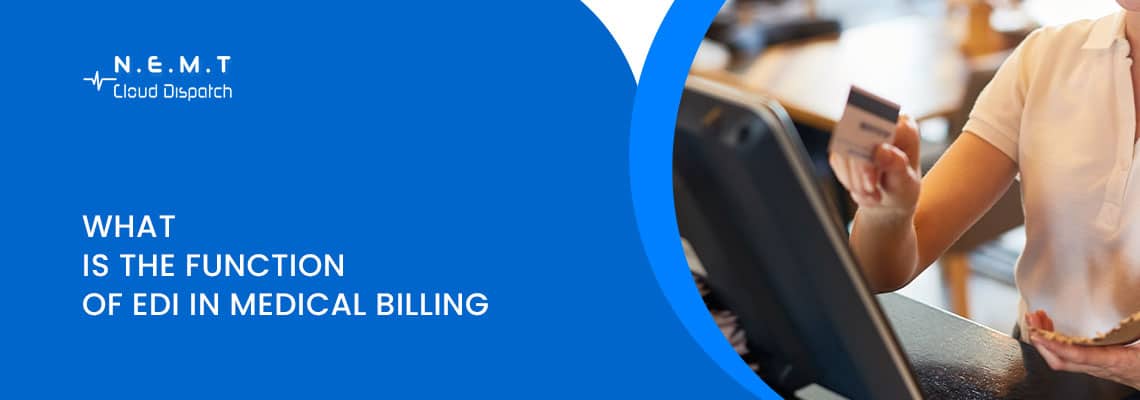Electronic Data Interchange (EDI) is a transformative technology that has revolutionized various industries, including healthcare. In medical billing, EDI enables the electronic exchange of standardized information between healthcare providers, insurance companies, and other stakeholders. This process replaces paper-based transactions, making healthcare billing more efficient, cost-effective, and accurate. At NEMT Cloud Dispatch let’s break down the role of EDI in medical billing from different angles.
Understanding EDI in Healthcare Billing
In healthcare, EDI refers to the electronic transfer of medical information such as patient data, billing claims, payments, and other critical records between organizations. Instead of relying on physical paperwork, EDI allows for the automation of tasks like submitting claims, checking patient eligibility, and managing invoices.
This method is governed by standards set by regulatory bodies such as the Health Insurance Portability. In addition, Health Insurance Portability and Accountability Act (HIPAA), ensures that all data exchanged adheres to the same format, regardless of the software used by each party. It supports various healthcare processes like claims submission, payment remittance, patient information exchange, and more.
How EDI Transforms Medical Billing Processes
EDI has significantly improved medical billing by streamlining communication between healthcare providers and payers. Here’s how:
- Claims Submission: EDI allows medical providers to submit claims electronically, reducing the time needed to process and review them. This ensures faster payments, fewer errors, and more reliable claim submissions.
- Eligibility Verification: Before services are rendered, healthcare providers can use EDI to instantly verify a patient’s insurance eligibility. This ensures services are covered, minimizing the chances of claim denial.
- Payment Processing: EDI allows payments to be processed electronically, ensuring quicker payments and reducing the paperwork needed for handling checks or manual payment systems.
- Tracking Claims and Payments: EDI helps medical billing staff track claims and payments in real time. They can easily see which claims are pending, approved, or denied, allowing faster follow-up on any discrepancies.
You May Also Read: How NEMT Billing Software Streamlines the Billing Process?
Top Advantages of Using EDI in Medical Billing
EDI offers several advantages in the medical billing industry:
Speed and Efficiency
The speed at which data can be exchanged is much faster than paper-based processes. EDI allows real-time sharing of information, making claims processing faster and minimizing delays.
Reduced Errors
Manually entering data increases the likelihood of mistakes. EDI reduces this risk by automating data exchange, ensuring information is transferred accurately between systems.
Cost Savings
With EDI, there’s less need for physical paperwork, mailing, and manual labor, leading to significant cost reductions in billing operations. Healthcare organizations save on administrative costs and reduce billing cycles.
Improved Security and Compliance
EDI adheres to strict security protocols, ensuring that sensitive patient data is protected during exchanges. Additionally, it ensures compliance with regulatory standards like HIPAA, which is critical for maintaining trust in the healthcare system.
Better Relationships with Payers
Since EDI enables more transparent and faster communication with insurance companies and other payers, disputes over claims can be resolved more quickly. This leads to improved relationships and a smoother revenue cycle.
You May Also Read:How Billing Software Enhances Your NEMT Operation?
Major EDI Transaction Formats in Healthcare Billing
Healthcare EDI transactions follow specific formats to ensure uniformity across the industry. Some of the major EDI transaction formats include:
- EDI 837: This is the most commonly used format for submitting healthcare claim information from providers to payers (insurance companies). It includes all the necessary patient, provider, and claim details.
- EDI 835: Used for payment remittance, this format conveys details of payments made to healthcare providers. It includes information on whether claims have been approved, denied, or adjusted.
- EDI 270/271: These transactions are used for healthcare eligibility inquiries. EDI 270 is sent by the provider to check a patient’s coverage, while EDI 271 is the response from the insurance company.
- EDI 276/277: These transactions track the status of claims. EDI 276 is used to inquire about the status of a submitted claim, and EDI 277 is the response indicating its current status.
- EDI 278: This transaction is used to request authorization for healthcare services. It helps ensure that the necessary approvals are in place before treatment is provided.
Key Components of EDI Systems in Medical Billing
Several key components make up an effective EDI system in medical billing:
Data Translation
EDI systems need to translate data from various formats (like paper or different software platforms) into the standardized EDI format. This ensures seamless communication between different entities.
Data Validation
A robust EDI system must be capable of validating data to ensure it’s complete and accurate before submitting claims. Any errors in the data can lead to rejections, delays, or denials.
Integration with Practice Management Systems
EDI systems must integrate smoothly with a healthcare provider’s practice management software. This allows providers to manage all aspects of billing, from claim submission to payment reconciliation, in one place.
Compliance with HIPAA
Since EDI deals with sensitive medical data, the system must ensure that all transactions comply with HIPAA standards. Data security and privacy are crucial to avoid any legal issues.
Interoperability
The EDI system should be able to communicate with a wide range of insurance companies, clearinghouses, and other healthcare entities. This ensures smooth operations even when dealing with multiple stakeholders.
Go for NEMT Invoicing & Billing Software
If you’re in the Non-Emergency Medical Transportation (NEMT) industry, EDI plays a crucial role in billing as well. NEMT providers need to submit claims and invoices to Medicaid or insurance companies for services rendered. Using EDI-enabled NEMT billing software can simplify this process by automating claim submission, tracking payments, and ensuring regulatory compliance.
NEMT invoicing and billing software, like NEMT Cloud Dispatch, can handle EDI transactions efficiently, allowing for real-time communication with insurance companies, faster payment cycles, and reduced billing errors. The software can manage everything from trip scheduling to submitting claims, making it a one-stop solution for NEMT providers looking to optimize their billing process.


